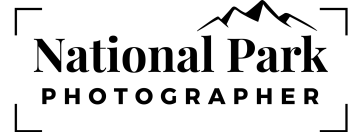
Length: .1 mi (.16 km)
Elevation Gain: None
Route Type: Out and Back
Difficulty: Easy
The Lower Terraces of the Mammoth Hot Springs are part of an extensive area of Travertine Terraces that make up the overall Mammoth Hot Springs area in Yellowstone National Park. As of June 2024, this northern-most edge of the area was exhibiting the most colorful displays of orange, brown, and green thermophiles. These are microscopic organisms that survive and thrive in the hot mineral rich water that bubbles up from the numerous hot springs in the area.
Accessing the Lower Terraces of the Mammoth Hot Springs in Yellowstone National Park
Starting Location: Mammoth Terraces Trailhead, Yellowstone National Park, WY
GPS (DD): 44.972660, -110.703944
This location is one of the easiest sites to access in the entire Mammoth Hot Springs complex. You will want to take the Mammoth Terraces Trail adjacent to the Liberty Cap formation. The parking lot is on west side of Grand Loop Road (Rt. 89) about .25 mile (.4 km) south of the Mammoth Hot Springs Hotel and is right next to the trail entrance. This short, wheelchair accessible boardwalk trail skirts the north edge of the Mammoth Hot Springs Terraces. Here you will get to walk alongside a beautiful area that appears to be colorful frozen waterfalls made up of white limestone (calcium carbonate). The colorful thermophiles add spectacular colors to the formations.
If you are staying at the Mammoth Hot Springs Hotel, this location is a short .25 mi (.4 km) walk. Stay on boardwalks and designated trails. It is dangerous to leave boardwalks and enter the hydrothermal areas. In addition to the lower terrace, there are connecting boardwalks and trails that will allow you to spend hours exploring the area.
Mammoth Village and the surrounding area, including the hot springs, is one of the few areas of Yellowstone National Park that remains open year around. This northern portion of the park offers numerous skiing and snowshoeing opportunities. Day tours into the interior of the park are available, all of which will make for exciting photo opportunities. Wolf enthusiasts will be especially interested in the Lamar Valley Wildlife Tour.
Weather and Elevation at the Mammoth Hot Springs
The elevation at Mammoth is 6,735 ft (2,052.83 m). Summer days can reach in to the 90’s F (32 C) with lows in the 50’s F (10 C). Spring and fall months experience highs in the mid 60’s-70’s F (15-20 C) and at night it can drop below freezing. In the winter months highs around 32 F (0 C). Nighttime temperatures can go as low as -20 F (-29 C) or colder.

Photography Tips at Mammoth Hot Springs
There are amazing photography opportunities year round in the Mammoth Hot Springs area. The ever changing seasons offer up ever changing photo opportunities. In 1988 I did a snowmobile tour (now only available with guided tours), to Old Faithful in December. It was a once in a lifetime opportunity to see Yellowstone in its winter blanket of snow. Wildlife, such as bison and elk, frequent the Mammoth Hot Springs area. Wolves frequent the Lamar Valley to the east of Mammoth.
The white travertine terraces of the Mammoth Hot Springs can be a challenge to photograph. The bright whites in the sun and shadows require a wide dynamic range. Consider using exposure bracketed HDR techniques to maximize your dynamic range.
The Golden Hour Light (one hour after sunrise and one hour before sunset) really looks great on the terraces with the golden light and shadows. Generally morning light is best because most of the terraces face easterly and the morning light provides the best lighting.
If you are taking your photos more toward midday, consider using a polarizing filter to cut glare from the wet white surfaces. For my photo featured on this page, I used a Canon R5, RF100-400mm F5.6-8 IS USM lens at 135mm, mounted on a panoramic nodal head. My settings were f/13, 1/160th sec. and ISO 400. The original image consists of 2335 individual focus bracketed images. These were processed down to 300 focus stacked images (10 rows X 30 columns) and then stitched into the 3.73 Gigapixel, 144 in. x 288 in. 300 dpi wall mural image. For information about purchasing this image see: Abba’s Creations Photography
Find Your Favorite Location
Plan to spend a day in the Mammoth area. There are so many photo opportunities all around the Mammoth Hot Springs. During the midday bad light there are also some good places to eat. If you have the time, include a visit to Fort Yellowstone.
Before making your trip, consider checking the official Yellowstone National Park website or contacting the park’s visitor center for the most up-to-date information on trail conditions, accessibility, and any recent changes. As with any visit to a national park, it’s important to follow park regulations, practice “Leave No Trace” principles, and prioritize safety while exploring this beautiful area. Enjoy your time exploring the natural wonders of the Mammoth Hot Springs!
Happy Travels!
John Freeman, Featured National Park Photographer
Want to learn more about Yellowstone National Park? Check out these maps, guides & books:
- Yellowstone National Park Map (National Geographic Trails Illustrated Map)
- Frommer’s Yellowstone and Grand Teton National Parks (Complete Guide)
- Yellowstone National Park: The First 150 Years
- Lonely Planet Yellowstone & Grand Teton National Parks 6 (National Parks Guide)
- Best Easy Day Hikes Yellowstone National Park (Best Easy Day Hikes Series)
- Yellowstone Treasures: The Traveler’s Companion to the National Park
- Yellowstone National Park (Images of America: Wyoming)
- A Weird and Wild Beauty: The Story of Yellowstone, the World’s First National Park
Please note, by making purchases through our affiliate links, you are supporting our mission to celebrate and showcase our National Parks and the photographers who frequent them. As an Amazon Associate, National Park Photographer earns from qualifying purchases at not cost to you. We appreciate your support.



